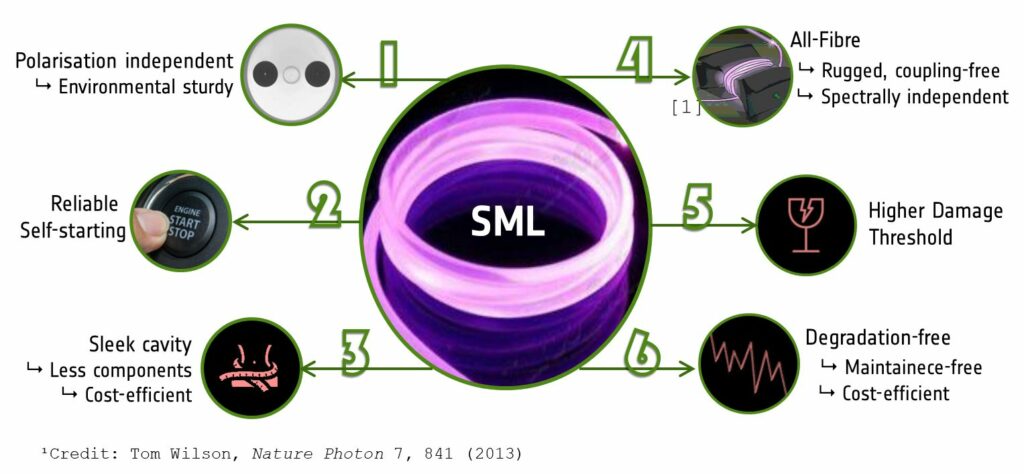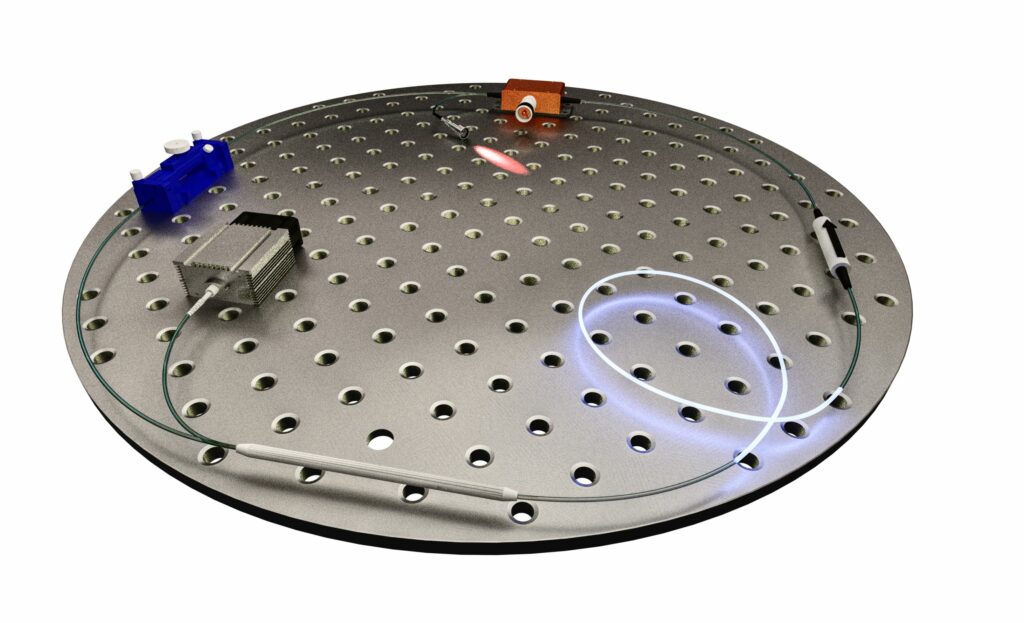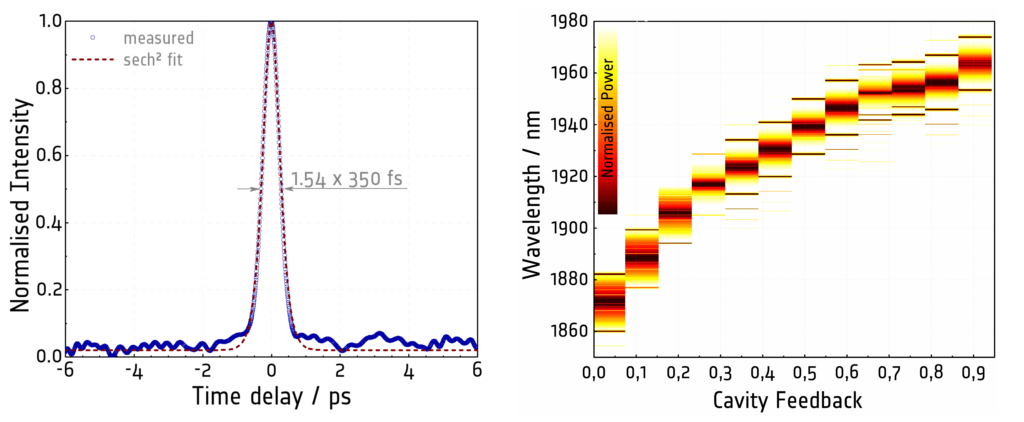- Home
- Junior Research Groups
- Ultrafast Fiber Lasers
- Research results
- Multitasking of a rare-earth-doped optical fibre in a laser cavity: performing as a gain, wavelength filter and saturable absorber at once
Multitasking of a rare-earth-doped optical fibre in a laser cavity: performing as a gain, wavelength filter and saturable absorber at once

21.12.2022
Ultrashort laser pulses are an influential innovation of the 20th century that swayed all kinds of gauging and manufacturing trades owing to their extreme irradiance or meticulous/precise time ruler. Although a vast number of mechanisms and apparatuses have been developed that are capable of creating such an ultrashort pulse operation (so-called material or artificial saturable absorber), they have inherent shortcomings that impede a convenient mass distribution – for example in cost-sensitive fieldwork at environmental or cultural heritage surveying, as well as for the biomedical sector, with its very high reliability requirements.
For instance “SESAMs”, widely used in industry, are restricted to a specific wavelength, best waged for around 1 µm lasers, are not all-fibre compatible so that one has to couple from the SESAM back into the fibre and are affected by degeneration over time causing extra recalibration and maintenance costs. The so-called all-fibre design is beneficial due to their maintenance-free operation and its high degree of compactification since no free-space coupling into the tiny core of a fibre (~ 5-10 µm) is necessary. For scientific record-breaking experiments, an artificial saturable absorber (the so-called nonlinear polarisation rotation technique) is often used, which is unfortunately inherently unstable against mutable environmental conditions, making this technique inappropriate for out-of-lab/real world applications. In recent years, this void has prompted scientists to develop a variety of new materials to serve as saturable absorber (the so-called 2D/few-layer saturable absorbers), all of which have rather low damage thresholds.

Figure 1:
Benefits of self-mode-locking compared to conventional used apparatuses
Ultrashort pulses without a modulator/saturable absorber
In other words, there is a serious urge for improved saturable absorbers. But what if one would not need an extra saturable absorber at all? Self-mode-locking may remedy this as it is characterised by the fact that no additional apparatus is required other than the active fibre that is anyway present. Indeed previous work has already established that a non-excited Thulium:fibre can exhibit a nonlinear saturable absorption, but, unfortunately, this effect has so far only been observed to a minor extent. It was accompanied by the extension of the laser resonator by tens of metres of standard single-mode fibre to increase the nonlinearity, which in turn increased the dispersion in the resonator to such a degree that the equilibrium of both effects necessary for the generation of a stable pulse (so-called solitons) only allowed pulses way longer than a picosecond; and in addition a slow pulse repetition rate is obtained.
In contrast, seeking opportunities to reduce costs, space and fragility of these lasers, we have found that the saturable absorption of a Thulium:fibre can be boosted through the targeted insertion of clustered Thulium ions. In these clusters, a certain process (so-called energy transfer upconversion) is more likely. However, this loss process declines with the irradiated power and the accompanying occupation of higher Thulium levels, which is similar to the functioning of a saturable absorber. Thus, Leibniz IPHT researchers carried out the theses, that by raising the number of clusters in the Thulium:fibre, the self-mode-locking effect might be improvable as well. For testing this hypothesis, the Ultrafast Fibre Lasers Work Group collaborated with the French company iXblue Photonics, who supplied unique fibres with anticipated high concentration of clusters. The group from the Institute of Photonics and Electronics from the Czech Academy of Sciences in Prague, leaded by Prof P. Peterka, supported with their fibre characterisation facility and detailed analysis of energy processes in active fibre. The fibre samples were extensively characterised in their different properties (refractive index profile, their fluorescence lifetime and of course their nonlinear saturable absorption for different lengths and wavelengths). To estimate the percentage of clusters, one of the only known non-saturable absorption measurements on Thulium:fibres is conducted. The best balance between the properties is gained with an as described Thulium:fibre equipped with about 20% Thulium clusters.
In laser experiments involving this Thulium:fibre, the researchers were able for the first time to break the picosecond barrier by means of self-mode-locked thulium:fibre laser. In fact, the following performance values could be achieved through a delightfully lean all-fibre ring design that contains only the most necessary components (cf. Figure 3: a pump laser input, an 80% output coupling, an unidirectional and polarisation controlling element consisting completely of standard single mode fibre): A seminal pulse duration as short as 350 fs with a fast repetition rate of 45 MHz, along with a remarkable average power of up to 80 mW is attained. This gives a pulse energy of about 1 nJ nearing the upper limit of the used pulse regime. The performance figures correspond to those possible with other SAs, but the decisive advance lies in the construction of the laser itself, which can be realised more cheaply and robustly than traditional concepts thanks to fewer components. Furthermore, the concept allows a higher degree of freedom in the design of the lasers, particularly concerning the signal wavelength.

Figure 2:
Schematic of the developed self-mode-locked tuneable fibre laser
Wide wavelength tuneability without spectral filtering
A second feature the researchers worked on is the tuneability of the signal wavelength, which is a paramount capability for many applications in the spectroscopy. Since the self-mode-locking scheme described above involves no wavelength dependence, in contrast to e. g. a SESAM it lends itself for this purpose. The exciting wide fluorescence of the Thulium:fibre of around 300 nm and more makes them consummate active media for a wavelength tuneable ultrashort pulse laser. Unfortunately, tuneable filters beyond the standard laser wavelengths in a narrow band around 1 and 1.5 µm are hardly purchasable, especially when taking into account that for ultrafast lasers in addition to the central wavelength offset, a wide passband is also required. Besides, these arrangements are usually free-beam coupled and hence susceptible to any movement and vibrations. Considering only the more rugged all-fibre solutions, the wavelength shift realised is generally limited to a couple nanometres to a few dozen nanometres.
However, if the special level structure of the Thulium:fibre is exploited in such a way that its absorption and emission wavelength spectrum is shifted by changing the degree of excited Thulium ions, the laser wavelength can also be adjusted without a spectral filter. The degree of excited Thulium ions is set by changing the intra-cavity power through a variable ratio of output coupling. Therefor the researchers added a special all-fibre device to the setup described above, whose coupling ratio can be set between 10 to 90 % by the distance of two evanescently coupled D-shaped fibres.
While the output coupling ratio is continuously changed, the central wavelength shifts uninterrupted up to 90 nm (1870-1960 nm) under retained mode-locking (cf. Figure 4). This almost doubles prior work on continuous wave Thulium:lasers with this technique and it is the first time that both techniques are combined in one arrangement.

Figure 3:
Characteristic ultrashort pulse autocorrelation trace and spectrum tuneabiltiy range
The researchers reckon that due to the universality and cost-efficiency of both principals, they can be transferred to other spectral domains which lack even more suitable saturable absorbers and tuneable spectral filter, such as the prospective mid infrared domain, which is in urgent need of advancement due to its spectroscopic “fingerprinting” capabilities.
Funded by:
Deutsche Forschungsgemeinschaft (DFG)
Project Partners:
Novosibirsk State University, Russia; Institute of Photonics and Electronics, The Czech Academy of Sciences, Czechia; iXblue Photonics, France; Ulyanovsk State University, Russia; Electromagnetism and Telecommunication Department, University of Mons, Belgium
In the image above:
Representation of the rare-earth fibre multitasking: signal gets amplified, selects an operation wavelength and experiences saturable absorption, forming ultrashort pulse
